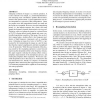Free Online Productivity Tools
i2Speak
i2Symbol
i2OCR
iTex2Img
iWeb2Print
iWeb2Shot
i2Type
iPdf2Split
iPdf2Merge
i2Bopomofo
i2Arabic
i2Style
i2Image
i2PDF
iLatex2Rtf
Sci2ools
SIP
2003
2003
Polyphase Antialiasing in Enlargements
Changing resolution of images is a common operation. It is also common to use simple, i.e., small interpolation kernels satisfying some ”smoothness” qualities that are determined in the spatial domain. Typical applications use linear interpolation or piecewise cubic interpolation. These are popular since the interpolation kernels are small and the results are acceptable. However, since the interpolation kernel, i.e., the impulse response, has a finite, and small length, the frequency domain characteristics are not good. Therefore, when we enlarge the image by a rational factor of ¢¡¤£¦¥¨§ , aliasing effects usually appear and cause a noticeable degradation in quality of the image. One such effect is jagged edges. Another effect is low frequency modulation of high frequency components such as sampling noise. Enlarging an image by a factor of ¢¡©£¥¨§ , is represented by first interpolating the image on a grid ¡ times finer than the original sampling grid, and...
| Added | 01 Nov 2010 |
| Updated | 01 Nov 2010 |
| Type | Conference |
| Year | 2003 |
| Where | SIP |
| Authors | Daniel Seidner |
Comments (0)

